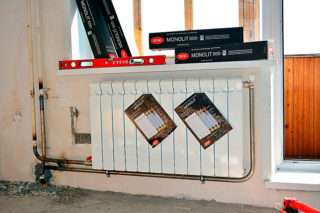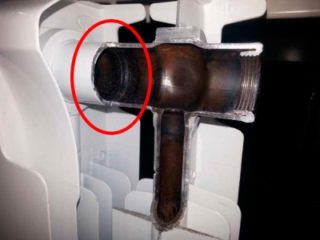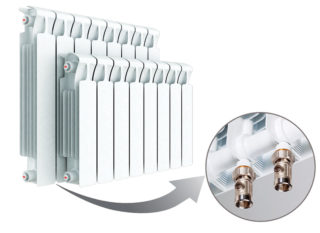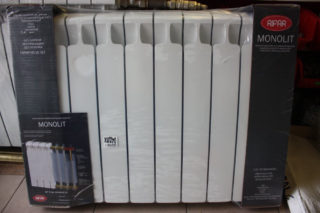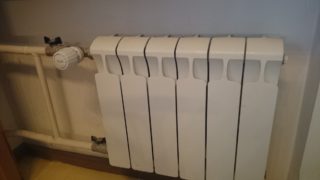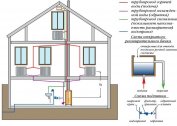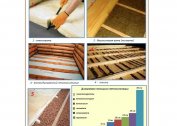Bimetal radiators are gradually, but confidently conquering the market. Rifar Monolith batteries stand out in the assortment. Quality and reliability are the main characteristics of the model.
The essence of bimetallic technology
A feature of bimetallic radiators is the use of two metals in the design.
The steel from which the inner filling is made is responsible for the strength and durability of the structure. The outer layer is made of aluminum, slightly susceptible to corrosion and gives the finished product an attractive appearance.
The meaning of the technology is as follows:
- Steel heat-conducting channels are welded with internal collectors, which are needed to connect the sections to each other.
- High pressure die casting. The inner steel frame is covered with an aluminum jacket.
- Assembly of finished radiators from several sections.
The advantages of the technology are due to the properties of metals:
- steel gives the structure strength;
- aluminum gives off heat well, looks attractive;
- bimetallic batteries are lighter than cast-iron counterparts; they carry increased pressure and water hammer.
The main problem of sectional products is the availability of joints. Mechanical joints are prone to leaks, corrosion, and destruction during water hammering. The Rifar Monolith 500 batteries are free from these shortcomings.
Features of the Monolith series
Externally, the batteries of the Russian company Rifar are similar to sectional analogues. The design feature is hidden in the designation "monolith".
In variants of execution (Monolit or SUPRemo) the concept of "section" in the general sense is absent. The inner part of the metal is made as a whole, without nipples and gaskets at the joints. Accordingly, the outer shell is also one-piece.
Monolith series heating radiators cannot be disassembled into separate sections, add a section to increase heat transfer or replace a component. Therefore, the calculation of heat transfer is carried out at the design stage.
To prevent corrosion, the inner surface of the tube is coated with a layer of silver. The absence of protrusions, minor irregularities makes the advancement of the coolant easier.
The manufacturer does not establish restrictions on the chemical composition of the coolant. The company guarantees the absence of corrosion when using industrial water or antifreeze in the system.
Patented welding technology makes the design close in characteristics to seamless. This increases tensile strength with increasing pressure.
The thickness of the inlet pipes corresponds to the thickness and diameter of the wiring pipes, which facilitates installation.
The cost of one section from the manufacturer is 880 rubles. To obtain the final cost, the number of sections is multiplied by this amount. Rule: the more sections, the cheaper the unit cost of one - in Monolith models does not work.
Important specifications
The technical parameters of Rifar Monolit 500 bimetallic radiators can be used in any buildings with heating systems that comply with GOST.
The manufacturer guarantees the technical specifications:
- working pressure - 100 Atm;
- pressure for tests - 150 Atm;
- short-term breaking pressure and load during tests according to GOST 31311-2005 - 250 Atm;
- maximum coolant temperature - 135 ° C;
- connecting size 3/4 ″;
- upon special order, delivery with 1/2 ″ nozzles is possible;
- interaxal distance of connecting branch pipes - 500 mm;
- dimensions, height, width, depth, mm - 577x80x100;
- heat transfer of one section - 196 W;
- internal volume of the section - 0.2 l;
- section weight - 2 kg;
- The number of sections in the finished product is from 4 to 14.
The preservation of these parameters within the normal range is guaranteed by the manufacturer for 25 years of operation.
Using a Monolith Battery
The plant recommends the use of batteries of this series for heating any residential, industrial and utility buildings.
The increased durability allows installation in high-rise buildings.
For production, steel and aluminum grades are used, which allow the installation of a Monolith battery in preschool institutions and schools, hospitals and catering facilities.
Corrosion-resistant coating does not deteriorate under conditions of short-term exposure to high humidity, so monolithic batteries can be used for heating basements and garages.
Installation requirements
All the benefits of Rifar Monolith batteries are only apparent with proper installation. Required recommendations are indicated in the product passport.
Before installation, a heating project is prepared in accordance with the governing documents GOST 31311-2005, SNiP 41-01-2003, SNiP 3.05.01-85 and СО 153–34.20.501-2003. The requirement is mandatory if the maintenance is planned to be entrusted to a specialized organization.
In private homes there is no such strict requirement, but to equip a reliable system, it is recommended to draw up a project - this will help in case of accidents to restore efficiency.
Installation works are carried out in accordance with the methodology of the Ministry of Construction; the organization responsible for further operation observes the progress of construction.
During installation, the radiator is naturally heated (cooled) to the temperature of the room where the installation is carried out. Using heaters to speed up the process is prohibited. The requirement is due to the fact that when the temperature changes, metal deformations occur and the joints with the supply pipes can lose their tightness.
Mandatory installation of taps with the ability to block the entrance and exit of the radiator.
The protective film is not removed before use, so as not to damage the coating.
In the opposite side from the inlet pipe, an air bleed valve is installed.
When tightening threaded connections, the force must not exceed 55 N / m to avoid breakage.
Transportation
It is permissible to deliver radiators by any means of transport. Stacks of products securely secured against movement.
Store products in enclosed spaces or under a canopy. Impact on the packaging and housing of aggressive chemicals.
As an exception, storage for up to 10 days is allowed in open areas protected from precipitation.
The distance from the floor to the lower edge of the device is chosen from 70 to 120 mm, and to the window sill of at least 80 mm - this is the optimal solution for heat transfer. 30-50 mm recede from the wall.
Strictly horizontal position will protect against frequent airing of the internal cavities of the product.
Valid Wiring Diagrams
It is permissible to use a side or bottom connection to the pipeline.
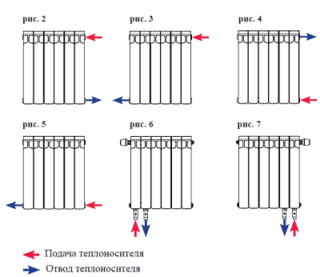
Figure 4 shows the worst of all options. In this case, the heat transfer will decrease by 20 - 30% with the number of sections up to 6 pcs. inclusive. The more sections, the greater the loss.
Important operating rules
Daily operating rules do not imply a large number of technological operations.
The factory recommends:
- regularly or if necessary, remove air through a special valve;
- Do not use aggressive liquids as additives in the coolant;
- sharply open the shut-off and control valves to avoid water hammer that adversely affects the connections.
The manufacturer has placed special operating requirements in a separate section of the instructions. It is strictly forbidden:
- strike and apply physical activity that can destroy the product;
- allow freezing of water circuits;
- connect the elements of the ground loop to the radiator;
- use unprepared water or liquid from external and underground sources;
- install the radiator in rooms with constant humidity above 75%, for example, in pools;
- remove water from the circuit in the summer;
You can not install a radiator in the hot water supply system of apartment buildings, for example, as a heated towel rail.
Types and equipment of radiators Refart Monolith
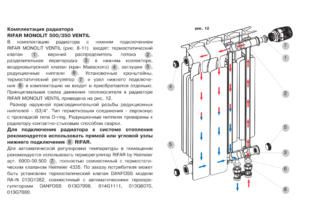 The designers of Rifar radiators have provided various versions of devices for convenient installation and replacement in old networks.
The designers of Rifar radiators have provided various versions of devices for convenient installation and replacement in old networks.
Models with a center distance of nozzles of 350 and 500 mm are available. This corresponds to the size of the vast majority of radiators on the market today and used previously.
To replace old equipment, you will not have to make changes to the design of the supply pipes, which means that you can replace the battery using a minimum set of tools.
The RIFAR MONOLIT package does not include any additional accessories. In this model, lateral connection to ½ or ¾ ”nozzles.
Plugs, air vents and brackets are also available at an additional cost.
The RIFAR MONOLIT 500/350 Ventil version allows connection according to schemes 6 and 7 from the figure above. Products are produced only by special order of installers or retail chains.
This package includes in addition to the radiator itself:
- thermostatic valve (temperature controller);
- flow distributors (upper and lower);
- reducing nipples;
- drain valve (Mayevsky);
- plugs for unused outputs.
Brackets are not included.
When ordering / buying, pay attention to the direction of connection (right or left). This information is important for the proper functioning of the radiator.
Innovative Rifar Monolith batteries are an excellent solution for creating heating systems operating at unstable pressure and temperature. Installation is simple and accessible to the user with minimal skills.
